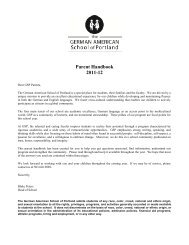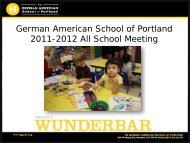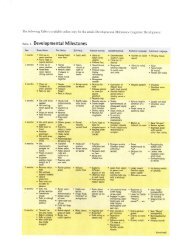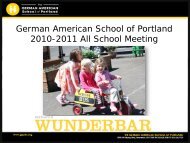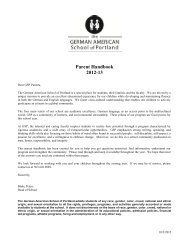St. Martin's Day/Laternenumzug - The German American School of ...
St. Martin's Day/Laternenumzug - The German American School of ...
St. Martin's Day/Laternenumzug - The German American School of ...
You also want an ePaper? Increase the reach of your titles
YUMPU automatically turns print PDFs into web optimized ePapers that Google loves.
<strong>St</strong>. <strong>Martin's</strong> <strong>Day</strong><br />
Every year on November 11, <strong>German</strong> children celebrate <strong>St</strong> <strong>Martin's</strong> <strong>Day</strong> as the start <strong>of</strong> Carnival season. In<br />
many regions children walk through the streets singing special songs. Sometimes they perform a little play<br />
with a very specific piece <strong>of</strong> Martin’s life. It is the story about how he meets a beggar on a cold night and,<br />
because he feels sorry for him, cuts his cloak in half to share it with the beggar. That is the legend <strong>of</strong> <strong>St</strong>.<br />
Martin, but who was he really<br />
<strong>St</strong>. Martin the Roman Soldier Martin was born in 316 a.d. as the son <strong>of</strong> a Roman Officer in what is now<br />
Hungary. He was raised in Pavia, Italy where he joined the army at age 15 as a soldier and later became an<br />
<strong>of</strong>ficer. Even during his military career he was known as a very compassionate man. When, on a cold<br />
winter’s day, he encountered a freezing beggar, he took his sword, split his wide cloak in two and gave the<br />
beggar half. <strong>The</strong> following night he had a dream where the beggar revealed himself as Jesus Christ. After<br />
this experience he decided to get baptized, left the military service and went to seek the Bishop Hilarus in<br />
the French town <strong>of</strong> Poitiers, who became his teacher.<br />
<strong>St</strong>. Martin – <strong>The</strong> Bishop Because Martin was so compassionate, he was very popular with the people.<br />
<strong>The</strong>y begged him to become Bishop <strong>of</strong> the town <strong>of</strong> Tours. A legend tells the story <strong>of</strong> Martin feeling<br />
unworthy <strong>of</strong> that honor and hiding out in a goose stall. However, the geese made so much noise that<br />
Martin was found – and as punishment Martin had the geese slaughtered and cooked. That is perhaps the<br />
reason that in some regions people eat a “Martinsgans” “Martinsgoose” on November 11 th . Martin<br />
eventually became Bishop and remained so for nearly 30 years. During that time it is said he healed the sick<br />
and performed numerous miracles. When he died at the age <strong>of</strong> almost 80, people came from near and far<br />
to attend his funeral – Martin had become famous.<br />
<strong>St</strong>. Martin – <strong>The</strong> Saint Martin was bestowed sainthood by the pope and is now the Patron Saint <strong>of</strong> many<br />
vocations. For vintners, barrel makers, farriers, weavers, Tailors, shepherds, hat makers and mill workers. In<br />
addition he also protects beggars and soldiers – and all pets. But why do you walk around with a lantern on<br />
<strong>St</strong>. Martin’s <strong>Day</strong> <strong>The</strong>re could be two reasons:<br />
First: Often people held candle light vigils at Martin’s grave, which could have developed into Lantern<br />
parades. Another origin <strong>of</strong> the Lantern tradition could be rooted in the yearly routine <strong>of</strong> farmers: For<br />
people around Martini, around November 11 th , light and fire became more important again. It got dark very<br />
early and the wood stoves were put back into service. In addition, farmers finished tending to their fields in<br />
the beginning <strong>of</strong> November. As thanks for the harvest, fires were lit on the fields after harvest time.<br />
Children made torches out <strong>of</strong> straw and paper, or “Trullichter”, which were hollowed out gourds and<br />
pumpkins. <strong>The</strong>n they made their way through town, asking neighbors for fruit and pastries. That is how the<br />
modern day Lantern parade could have developed.<br />
<strong>The</strong> Songs <strong>The</strong>re are many songs that the children sing; here is one, with an English translation:<br />
Ich geh' mit meiner Laterne<br />
Und meine Laterne mit mir.<br />
Dort oben leuchten die <strong>St</strong>erne,<br />
Hier unten, da leuchten wir.<br />
(Mein Licht ist aus,<br />
Wir gehn nach Haus,<br />
Rabimmel, rabammel, rabum.)<br />
I'm walking with my lantern<br />
And my lantern goes with me.<br />
Above the stars are shining,<br />
and we are shining below.<br />
(My light has gone out,<br />
We're going home,<br />
rabimmel, rabammel, rabum)



